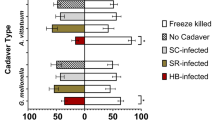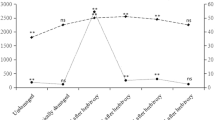Abstract
Predators can affect prey in two ways—by reducing their density (consumptive effects) or by changing their behavior, physiology or other phenotypic traits (non-consumptive effects). Understanding the cues and sensory modalities prey use to detect predators is critical for predicting the strength of non-consumptive effects and the outcome of predator–prey encounters. While predator-associated cues have been well studied in aquatic systems, less is known about how terrestrial prey, particularly insect larvae, detect their predators. We evaluated how Colorado potato beetle, Leptinotarsa decemlineata, larvae perceive predation risk by isolating cues from its stink bug predator, the spined soldier bug, Podisus maculiventris. When exposed to male “risk” predators that were surgically manipulated so they could hunt but not kill, beetles reduced feeding 29 % compared to controls. Exposure to risk females caused an intermediate response. Beetles ate 24 % less on leaves pre-exposed to predators compared to leaves never exposed to predators, indicating that tactile and visual cues are not required for the prey’s response. Volatile odor cues from predators reduced beetle feeding by 10 % overall, although male predators caused a stronger reduction than females. Finally, visual cues from the predator had a weak effect on beetle feeding. Because multiple cues appear to be involved in prey perception of risk, and because male and female predators have differential effects, beetle larvae likely experience tremendous variation in the information about risk from their local environment.




Similar content being viewed by others
References
Ache BW, Young JM (2005) Olfaction: diverse species, conserved principles. Neuron 48:417–430. doi:10.1016/j.neuron.2005.10.022
Aldrich JR, Cantelo WW (1999) Suppression of Colorado potato beetle infestation by pheromone-mediated augmentation of the predatory spined soldier bug, Podisus maculiventris (Say) (Heteroptera: pentatomidae). Agric For Entomol 1:209–217. doi:10.1046/j.1461-9563.1999.00026.x
Aldrich JR, Kochansky J, Abrams C (1984a) Attractant for a beneficial insect and its parasitoids: pheromone of the predatory spined soldier bug, Podisus maculiventris (Hemiptera: pentatomidae). Environ Entomol 13:1031–1036
Aldrich JR, Kochansky J, Lusby W, Sexton J (1984b) Semiochemicals from a predaceous stink bug, Podisus maculiventris (Hemiptera: pentatomidae). J Wash Acad Sci 74:39–46
Aldrich JR, Lusby W, Kochansky J, Abrams C (1984c) Volatile compounds from the predatory insect Podisus maculiventris (Hemiptera: pentatomidae): male and female metathoracic scent gland and female dorsal abdominal gland secretions. J Chem Ecol 10:561–568
Beckerman AP, Uriarte M, Schmitz OJ (1997) Experimental evidence for a behavior-mediated trophic cascade in a terrestrial food chain. Proc Natl Acad Sci USA 94:10735–10738
Bernot RJ, Turner AM (2001) Predator identity and trait-mediated indirect effects in a littoral food web. Oecologia 129:139–146. doi:10.1007/s004420100705
Boer GD, Hanson FE (1987) Differentiation of roles of chemosensory organs in food discrimination among host and non-host plants by larvae of the tobacco hornworm, Manduca sexta. Physiol Entomol 12:387–398
Boiteau G, Alyokhin A, Ferro DN (2003) The Colorado potato beetle in movement. Can Entomol 135:1–22
Bolker BM, Brooks ME, Clark CJ, Geange SW, Poulsen JR, Stevens MHH, White JS (2008) Generalized linear mixed models: a practical guide for ecology and evolution. Trends Ecol Evol 24:127–135
Clercq PD, Degheele D (1994) Laboratory measurement of predation by Podisus maculiventris and P. sagitta (Hemiptera: pentatomidae) on beet armyworm (Lepidoptera: Noctuidae). J Econ Entomol 87:76–83
Ferrari MCO, Messier F, Chivers DP (2007) Variable predation risk and the dynamic nature of mosquito antipredator responses to chemical alarm cues. Chemoecology 17:223–229. doi:10.1007/s00049-007-0380-1
Ferrari MCO, Wisenden BD, Chivers DP (2010) Chemical ecology of predator–prey interactions in aquatic ecosystems: a review and prospectus. Can J Zool 88:698–724. doi:10.1139/Z10-029
Ferro DN (1983) Crop loss assessment of the Colorado potato beetle (Coleoptera: chrysomelidae) on potatoes in western Massachusetts. J Econ Entomol 76:349–356
Gerber B, Stocker RF (2007) The Drosophila larva as a model for studying chemosensation and chemosensory learning: a review. Chem Senses 32:65–89. doi:10.1093/chemse/bjl030
Griffin CAM, Thaler JS (2006) Insect predators affect plant resistance via density-and trait-mediated indirect interactions. Ecol Lett 9:338–346. doi:10.1111/j.1461-0248.2005.00880.x
Halaj J, Wise DH (2001) Terrestrial trophic cascades: how much do they trickle? Am Nat 157:262–281. doi:10.1086/319190
Hare JD (1990) Ecology and management of the Colorado potato beetle. Annu Rev Entomol 35:81–100
Harris MO, Foster SP, Bittar T, Ekanatake K, Looij K, Howard A (1995) Visual behaviour of neonate larvae of the light brown apple moth. Entomol Exp Appl 77:323–334
Hlivko JT, Rypstra AL (2003) Spiders reduce herbivory: nonlethal effects of spiders on the consumption of soybean leaves by beetle pests. Ann Entomol Soc Am 96:914–919
Hough-Goldstein J, McPherson D (1996) Comparison of Perillus bioculatus and Podisus maculiventris (Hemiptera:pentatomidae) as potential control agents of the Colorado potato beetle (Coleoptera:Chrysomelidae). J Econ Entomol 89:1116–1123
Kaplan I, Thaler JS (2010) Plant resistance attenuates the consumptive and non-consumptive impacts of predators on prey. Oikos 119:1105–1113. doi:10.1111/j.1600-0706.2009.18311.x
Kaplan I, McArt SH, Thaler JS (2014) Plant defenses and predation risk differentially shape patterns of consumption, growth, and digestive efficiency in a guild of leaf-chewing insects. Plos ONE (in press)
Kiesecker JM, Chivers DP, Anderson M, Blaustein AR (2002) Effect of predator diet on life history shifts of red-legged frogs, Rana aurora. J Chem Ecol 28:1007–1015
Landolt PJ, Tumlinson JH, Alborn DH (1999) Attraction of Colorado potato beetle (Coleoptera: Chrysomelidae) to damaged and chemically induced potato plants. Environ Entomol 28:973–978
Lima SL (1998) Nonlethal effects in the ecology of predator–prey interactions. Bioscience 48:25–34
McCauley SJ, Rowe L, Fortin MJ (2011) The deadly effects of “nonlethal” predators. Ecology 92:2043–2048
McIntosh AR, Peckarsky BL (2004) Are mayfly anti-predator responses to fish odor proportional to risk? Arch Hydrobiol 160:145–151
Mizutani A, Toh Y (1998) Behavioral analysis of two distinct visual responses in the larva of the tiger beetle (Cicindela chinensis). J Comp Physiol A 182:277–286. doi:10.1007/s003590050178
Nelson EH, Matthews CE, Rosenheim JA (2004) Predators reduce prey population growth by inducing changes in prey behavior. Ecology 85:1853–1858
Ninkovic V, Feng Y, Olsson U, Pettersson J (2013) Ladybird footprints induce aphid avoidance behavior. Biol Control 65:63–71. doi:10.1016/j.biocontrol.2012.07.003
Nordenhem H, Nordlander G (1994) Olfactory oriented migration through soil by root-living Hylobius abietis (L.) larvae (Col., Curculionidae). J Appl Entomol 117:457–462
Peckarsky BL, McIntosh AR, Taylor BW, Dahl J (2002) Predator chemicals induce changes in mayfly life history traits: a whole-stream manipulation. Ecology 83:612–618
Preisser EL, Bolnick DI, Benard MF (2005) Scared to death? The effects of intimidation and consumption in predator–prey interactions. Ecology 86:501–509
Ramirez RA, Crowder DW, Snyder GB, Strand MR, Snyder WE (2010) Antipredator behavior of Colorado potato beetle larvae differs by instar and attacking predator. Biol Control 53:230–237. doi:10.1016/j.biocontrol.2010.01.004
Rosell F and Czech A (2000) Responses of foraging Eurasian beavers Castor fiber to predator odours. Wildl Biol 6:13–21
Rosier RL, Langkilde T (2011) Behavior under risk: how animals avoid becoming dinner. Nat Educ Knowl 2(11):8
Rypstra AL, Buddle CM (2013) Spider silk reduces insect herbivory. Biol Lett 9:20120948. doi:10.1098/rsbi.2012.0948
Sakaluk SK (1990) Sexual selection and predation: balancing reproductive and survival needs. In: Evans DL, Schmidt JO (eds) Insect defenses: adaptive mechanisms and strategies of prey and predators. State University of New York Press, New York, pp 63–91
Saxena KN, Khattar P (1977) Orientation of Papilio demoleus larvae in relation to size, distance, and combination pattern of visual stimuli. J Insect Physiol 23:1421–1428
Schmitz OJ (1998) Direct and indirect effects of predation and predation risk in old-field interaction webs. Am Nat 151:327–342. doi:10.1086/286122
Schmitz OJ, Beckerman AP, O’Brien KM (1997) Behaviorally mediated trophic cascades: effects of predation risk on food web interactions. Ecology 78:1388–1399
Sheriff MJ, Krebs CJ, Boonstra R (2009) The sensitive hare: sublethal effects of predator stress on reproduction in snowshoe hares. J Anim Ecol 78:1249–1258
Sullivan TP, Crump DR (1984) Influence of mustelid scent gland compounds on suppression of feeding by snowshoe hares (Lepus americanus). J Chem Ecol 10:1809–1821
Swihart RK, Pignatello JJ, Mattina MJI (1991) Aversive responses of white-tailed deer, Odocoileus virginianus, to predator urines. J Chem Ecol 17:767–777
Tanaka K, Uda Y, Ono U, Nakagawa T, Suwa M, Yamaoka R, Touhara K (2009) Highly selective tuning of a silkworm olfactory receptor to a key mulberry leaf volatile. Curr Biol 19:881–890
Telang A, Li Y, Noriega FG, Brown MR (2006) Effects of larval nutrition on the endocrinology of mosquito egg development. J Exp Biol 209:645–655. doi:10.1242/jeb.02026
Thaler JS, McArt SH, Kaplan I (2012) Compensatory mechanisms for ameliorating the fundamental trade-off between predator avoidance and foraging. Proc Natl Acad Sci U S A 109:12075–12080. doi:10.1073/pnas.1208070109
Thuppil V, Coss RG (2013) Wild Asian elephants distinguish aggressive tiger and leopard growls according to perceived danger. Biol Lett 9(5). doi:10.1098/rsbl.2013.0518
Webster DB, Webster M (1971) Adaptive value of hearing and vision in kangaroo rat predator avoidance. Brain Behav Evol 4:310–322
Werner EE, Peacor SD (2003) A review of trait-mediated indirect interactions in ecological communities. Ecology 84:1083–1100
Wilde JD (1958) Host plant selection in the Colorado beetle larva. Entomol Exp Appl 1:14–22
Williams JL, Wise DH (2003) Avoidance of wolf spiders (Araneae: lycosidae) by striped cucumber beetles (Coleoptera: Chrysomelidae): laboratory and field studies. Environ Entomol 32:633–640
Zanette LY, White AF, Allen MC, Clinchy M (2011) Perceived predation risk reduces the number of offspring songbirds produce per year. Science 334:1398–1401
Acknowledgments
We thank Alyssa Cowles, Elizabeth Davidson-Lowe, Stephen Pecylak and Marie Russel for assistance in running experiments and the Cornell Plant-Interactions Group for valuable discussions. We also thank Anurag Agrawal, Jared Ali, Charlie Linn, the Thaler and Poveda laboratories, and Michael Sheriff for comments on the manuscript and Chris Stieha for help with statistics. This project was supported by Hatch grant 139-7406 and NIFA 2014-67013-21785 to J.S.T. The authors have no financial conflicts to declare. All experiments comply with current US laws.
Author information
Authors and Affiliations
Corresponding author
Additional information
Communicated by Michael Sheriff.
Rights and permissions
About this article
Cite this article
Hermann, S.L., Thaler, J.S. Prey perception of predation risk: volatile chemical cues mediate non-consumptive effects of a predator on a herbivorous insect. Oecologia 176, 669–676 (2014). https://doi.org/10.1007/s00442-014-3069-5
Received:
Accepted:
Published:
Issue Date:
DOI: https://doi.org/10.1007/s00442-014-3069-5




